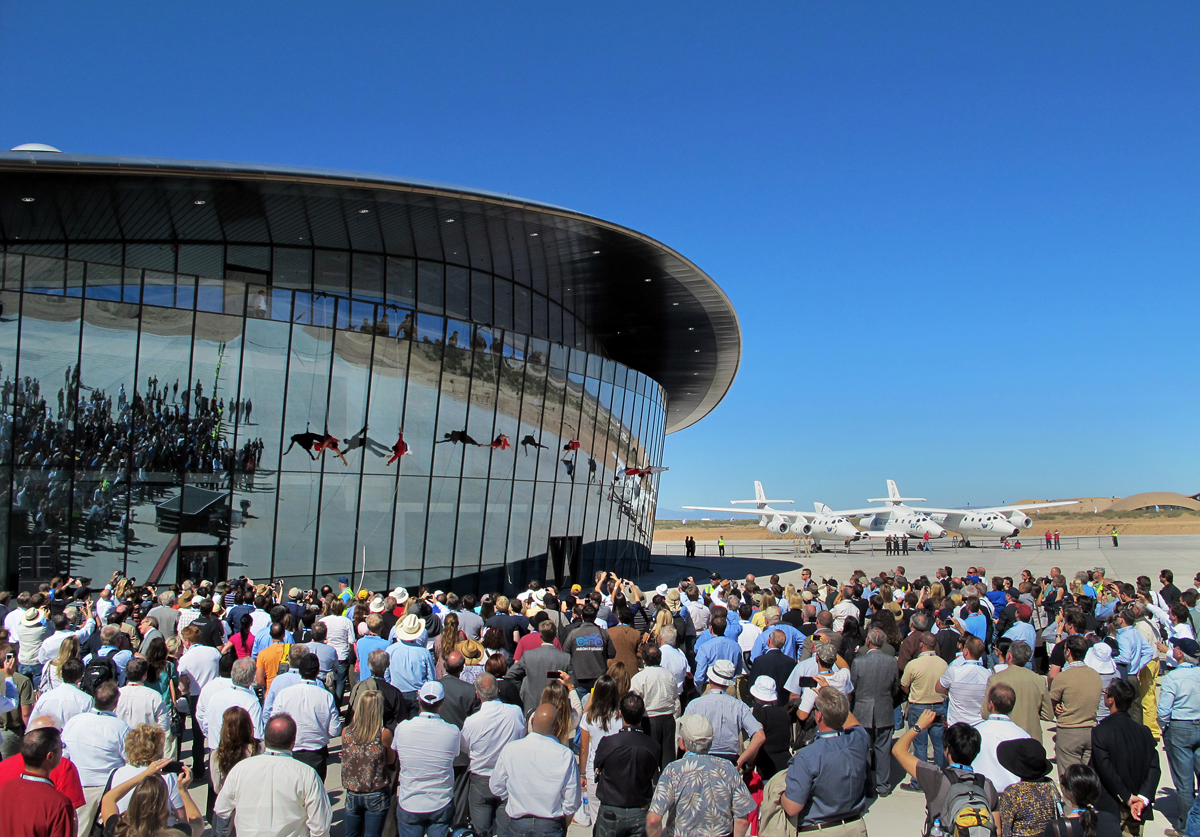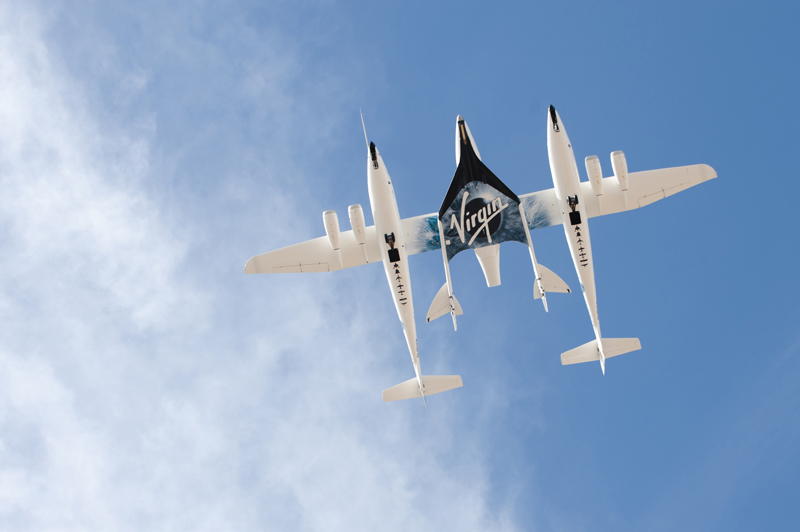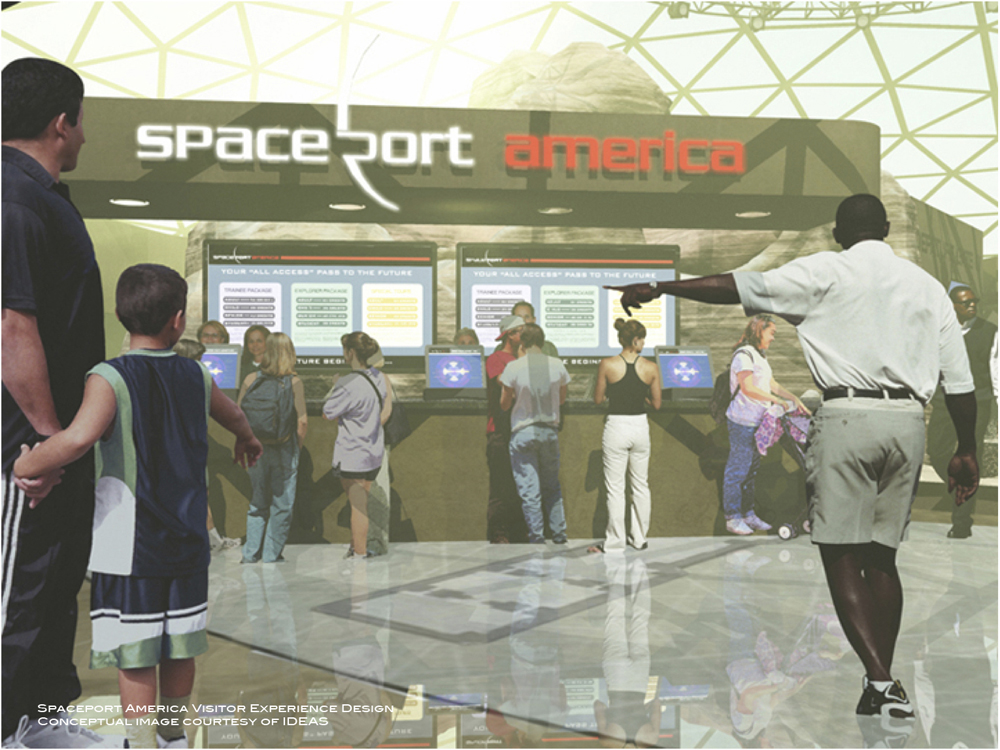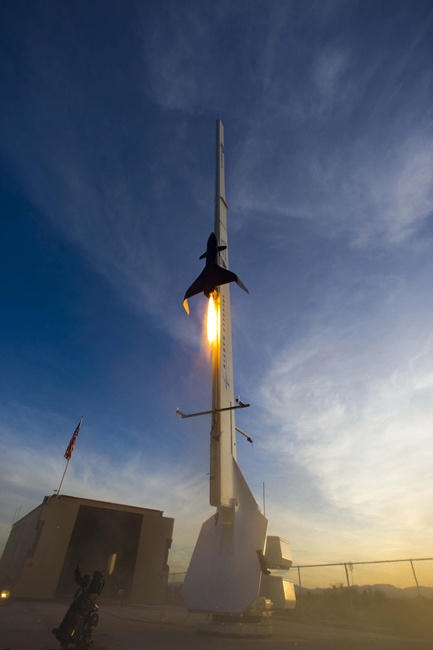
High-Tech 'Spaceport America' Readies for Space Tourists

Spaceport America, the world's first purpose-built commercial spaceport, is taking shape in southern New Mexico, not only as an outbound and incoming hub for tourists who ascend to and return from suborbital heights, but also as a high-tech haven for experimental craft that push new ways to access space.
While media attention is being paid to the futuristic Terminal Hangar Facility that is to be utilized by spaceline operator Virgin Galactic, how best to push forward onthe larger picture of commercial space is a looming question.
Spaceport America is billed as the first of its kind. The desert near here is dotted with Spaceport America infrastructure, planted approximately 45 miles north of Las Cruces, N.M. This gateway to space covers 18,000 acres of land.
“There are still a lot of things to do at Spaceport America,” said Christine Anderson, executive director of the New Mexico Spaceport Authority (NMSA), which oversees the spaceport project, in an exclusive interview with SPACE.com. She said the futuristic facility is in its second phase of construction. [Photos: Spaceport America Takes Shape]

Unexpected city
At present, Spaceport America is an "unexpected city in the middle of the high desert of New Mexico … a taste of much more to come," Anderson said during the International Symposium for Personal and Commercial Spaceflight, held here Oct. 19-20.
Spaceport America is being built for $209 million and is financed so far entirely by state taxpayer money. But public funds subsidizing the spaceport will end in two years' time.
Get the Space.com Newsletter
Breaking space news, the latest updates on rocket launches, skywatching events and more!
"By December 2013, we have to be totally self-sustaining," Anderson said. "I’m moving from a state-funded enterprise to a self-sustained enterprise. And that’s an interesting transition," she said, adding that the search for private investors is ongoing.
"There are all kinds of opportunities for private investment as we build out Spaceport America," Anderson said.

Terrestrial traveler
Part of that build-out is finishing a vertical rocket launch area. All the utilities, waste water system and other aspects are on checklist status, Anderson said. To honor the "viewshed," the vertical launch area can’t be hugely tall, she said, and must be nonreflective to honor the stunning area in which it sits.
“Next year, we are expecting to launch eight more vertical launches. That’s just in one year … and it signals an uptick in commercial space,” Anderson added. Another add to the spaceport is a paved southern road, making the site easier to access from El Paso, Texas, or Las Cruces.
Another upgrade to Spaceport America, Anderson said, is to create a visitor experience. Last July, the New Mexico Spaceport Authority announced the selection of Integrity Arts & Technology, Inc. (known as IDEAS) as the contractor to develop the “Spaceport America Visitor Experience,” an attraction that would offer a mix of entertainment and education.
That visitor experience is to embrace the general public, Anderson said, “even if you are not a space traveler, you could be a terrestrial traveler and enjoy Spaceport America.”
Anderson said that high on her agenda is offering launch customers a lean, efficient and streamlined set of procedures for utilizing Spaceport America.
"Because we are leaner," Anderson said, "our overhead is very low, so our costs are very low for certain kinds of missions. We are really accustomed to reusable launch vehicles, so that’s our market. That’s the holy grail…that’s where everybody wants to get to. So I think we’re positioned well."

Virgin Galactic territory
The recently-dedicated Spaceport America Terminal Hangar Facility is labeled as the "Virgin Galactic Gateway to Space" by British billionaire and adventurer Richard Branson. He is bankrolling the spaceline company Virgin Galactic, which will anchor operations at Spaceport America using the passenger-carrying WhiteKnightTwo/SpaceShipTwo suborbital launch system.
That hardware continues to undergo shakeout by Mojave, Calif.-based company Scaled Composites. Still to come are critical in-flight tests of SpaceShipTwo powered by a hybrid rocket motor.
According to George Whitesides, Virgin Galactic president and chief executive officer, in-vehicle rocket tests of SpaceShipTwo are anticipated to begin in the first half of 2012. “I think we need to see how things go over the next few months before we determine which quarter.”
Spaceport America sports a nearly two-mile long, 200 foot wide "spaceway" — a specially built runway that can handle Virgin Galactic’s use of the WhiteKnightTwo/SpaceShipTwo dual-action system. [Gallery –SpaceShipTwo Makes First Glide Flight]
But how soon commercial suborbital space treks will begin for passengers flying out of Spaceport America is still anybody’s guess.
"I can’t tell you when," Anderson said. "As Virgin Galactic has said, they will fly when it is safe to fly … which is exactly the right answer. I’ve been involved enough to know it is rocket science. It’s going to take a while," she said.
Contracted launches
Meanwhile, suborbital rocket provider UP Aerospace of Denver has been awarded launch contracts from NASA and the U.S. Department of Defense (DoD) Operationally Responsive Space Office.
Payloads from the agencies would be flown out of Spaceport America in New Mexico. Due to the increased activity and interest in a higher performance booster, UP Aerospace is accelerating the development of a SpaceLoft Heavy suborbital booster, said Jerry Larson, president of UP Aerospace Inc.
"We are currently preparing for many contracted launches and a very busy next few years at Spaceport America," Larson said. Next year could double the number of contracted launches that UP Aerospace has done at Spaceport America in the past six years, he told SPACE.com.
"This is an exciting turn of events for UP Aerospace and the space technology research sector," Larson said. "NASA is putting its trust in companies like ours to lift high-valued technology demonstration payloads into sub-orbital space. This contract, along with our DoD contract, will keep us very busy at Spaceport America over the next two years."
Leonard David has been reporting on the space industry for more than five decades. He is a winner of this year's National Space Club Press Award and a past editor-in-chief of the National Space Society's Ad Astra and Space World magazines. He has written for SPACE.com since 1999.
Join our Space Forums to keep talking space on the latest missions, night sky and more! And if you have a news tip, correction or comment, let us know at: community@space.com.

Leonard David is an award-winning space journalist who has been reporting on space activities for more than 50 years. Currently writing as Space.com's Space Insider Columnist among his other projects, Leonard has authored numerous books on space exploration, Mars missions and more, with his latest being "Moon Rush: The New Space Race" published in 2019 by National Geographic. He also wrote "Mars: Our Future on the Red Planet" released in 2016 by National Geographic. Leonard has served as a correspondent for SpaceNews, Scientific American and Aerospace America for the AIAA. He has received many awards, including the first Ordway Award for Sustained Excellence in Spaceflight History in 2015 at the AAS Wernher von Braun Memorial Symposium. You can find out Leonard's latest project at his website and on Twitter.









